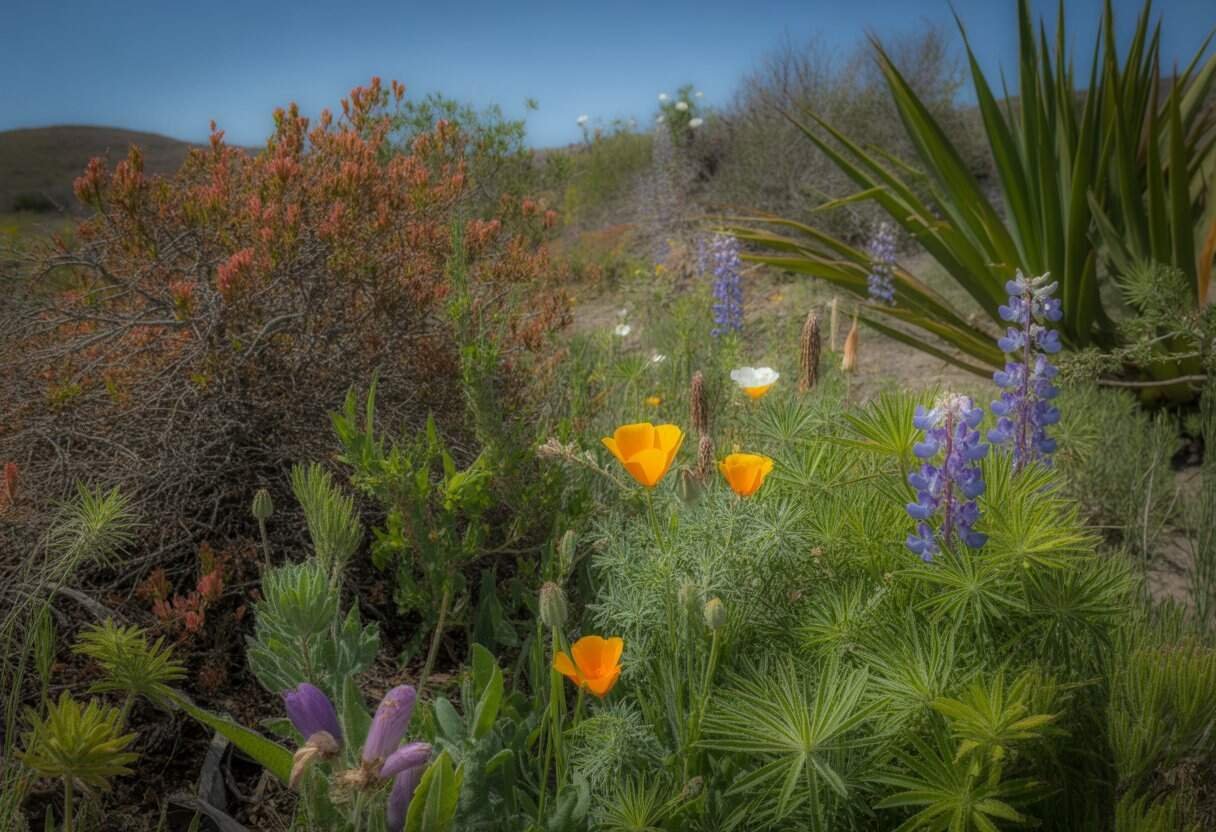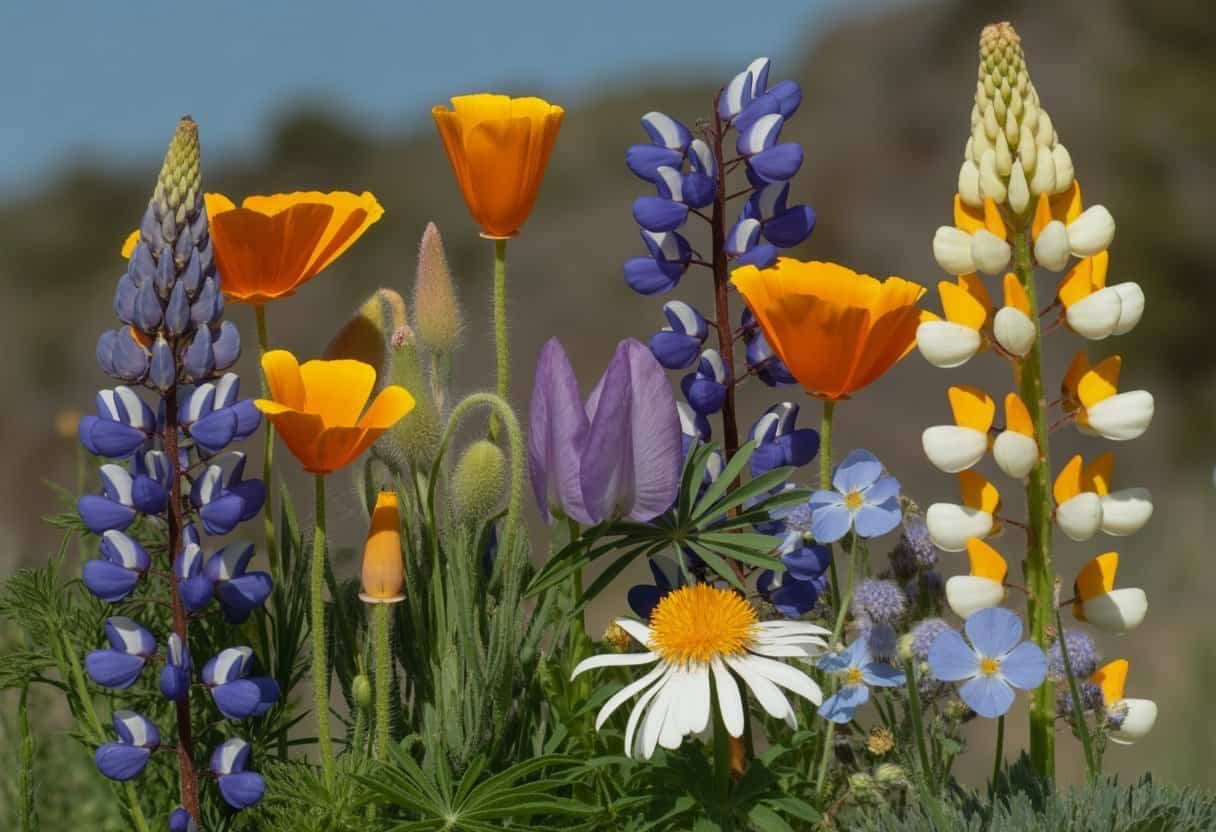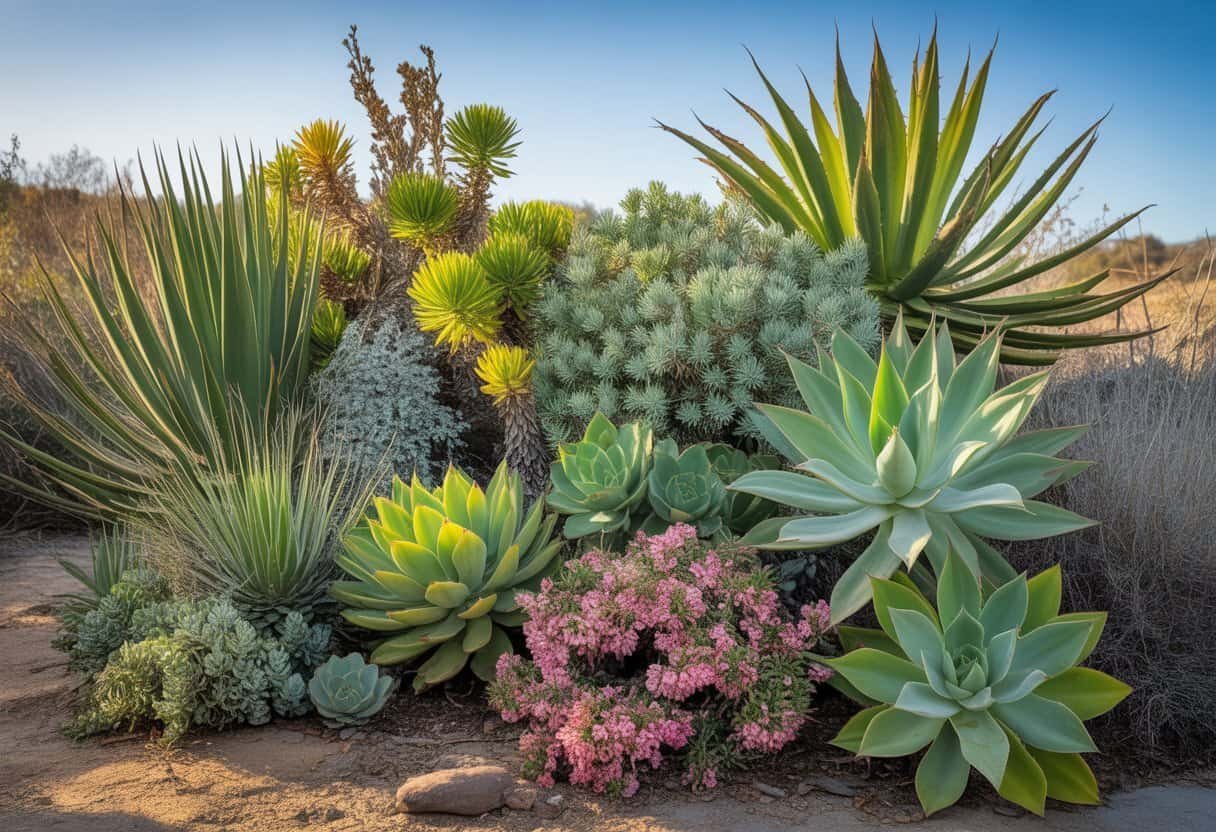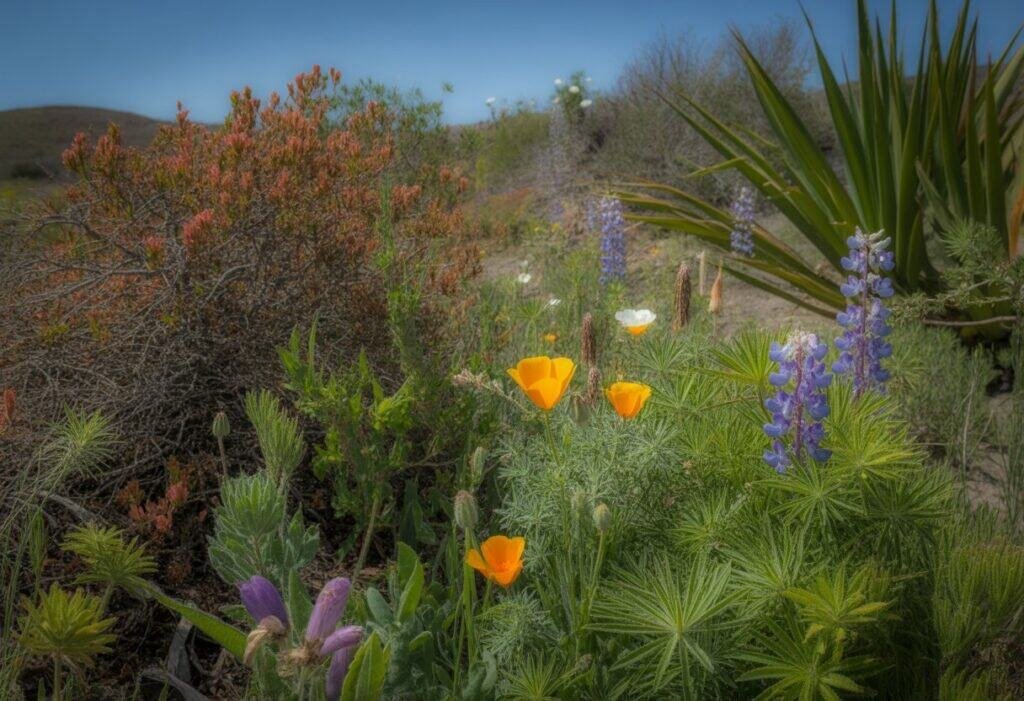California’s native plants offer a unique glimpse into the state’s natural heritage. From coastal bluffs to mountain slopes, these plants have adapted to thrive in California’s diverse landscapes and climate.
They’ve evolved over thousands of years to survive with minimal water and care.

Growing native plants in your garden helps support local wildlife while conserving water and reducing maintenance needs. Birds, butterflies, and bees depend on these plants for food and shelter.
Many California natives display stunning colors and textures that can transform any garden into a beautiful, sustainable space.
Native plants connect us to California’s natural history and unique ecological identity. They tell stories of adaptation and resilience that stretch back long before human settlement.
By choosing natives for our gardens, we help preserve California’s botanical treasures for future generations.
Key Takeaways
- California native plants are adapted to local conditions, requiring less water and maintenance than non-native species.
- Native plants provide essential habitat and food for local wildlife including pollinators and birds.
- Incorporating native species into gardens helps preserve California’s botanical heritage while creating sustainable landscapes.
What Are California Native Plants?
California native plants evolved naturally in the state’s diverse landscapes long before European settlement. These plants adapted to California’s unique climate, soils, and ecological conditions over thousands of years.
Definition and Characteristics
California native plants are species that grew in California before European settlers arrived. They developed specific traits to thrive in the state’s many environments.
Native plants can be trees like the Coast Live Oak, shrubs such as Manzanita, or wildflowers like California Poppies. They’re found in diverse habitats from coastal areas to mountains, deserts, and valleys.
These plants share key characteristics:
- Drought tolerance—many need little water once established
- Adaptation to local soil conditions
- Resistance to regional pests and diseases
- Seasonal growth patterns aligned with California’s climate
Native plants often have deep root systems that help them survive dry periods. They also form relationships with local pollinators, creating interdependent ecological networks.
Importance of Native Species
Native plants form the foundation of California’s ecosystems. They provide essential habitat and food for wildlife that co-evolved with them over millennia.
Birds, butterflies, and bees rely on native plants for shelter and nutrition. The Western Tiger Swallowtail butterfly, for example, depends on native willows and cottonwoods to complete its life cycle.
Native species offer practical benefits for human landscapes too:
- Require less water than non-native alternatives
- Need minimal fertilizers or pesticides
- Reduce maintenance and resource costs
- Create distinctive regional character
Using native plants in gardens and public spaces helps conserve water—a precious resource in California’s drought-prone climate. Their deep roots help prevent erosion and improve soil health.
Role in California’s Biodiversity
California ranks as one of the world’s biodiversity hotspots with over 6,500 native plant species. About 30% of these plants grow nowhere else on Earth.
This diversity comes from California’s varied topography, soils, and microclimates. The state contains many ecological zones, from coastal sage scrub to alpine meadows, each supporting unique plant communities.
Native plants form the base of food webs that support countless animal species. They provide:
- Nectar for pollinators
- Seeds and fruits for birds and mammals
- Cover for wildlife
- Structure for complex ecosystems
When native plant populations decline, entire ecological networks can unravel. Conservation efforts focus on protecting remaining native habitats and restoring areas with appropriate native species.
Iconic California Native Flowers

California’s landscape features beautiful native flowers that have adapted to the state’s unique climate. These plants thrive with minimal water and provide essential habitat for local wildlife.
California Poppy and Eschscholzia Californica
The California poppy (Eschscholzia californica) became the state flower in 1903. This bright orange flower blooms from February to September across California’s hills and valleys.
California poppies grow 12-18 inches tall with delicate, feathery leaves. Their cup-shaped flowers close at night and during cold, windy weather.
These drought-tolerant plants need little water once established. They self-seed readily, creating stunning orange carpets across landscapes.
Native Americans used California poppies for both food and medicine. The plant contains mild sedative properties that were traditionally used to treat toothaches and insomnia.
Poppies attract beneficial insects like bees and butterflies, making them valuable additions to gardens supporting pollinators.
California Fuchsia and Epilobium Canum
California fuchsia (Epilobium canum) displays vibrant red-orange tubular flowers from late summer through fall. This timing provides crucial nectar when many other plants have finished blooming.
These plants grow 1-3 feet tall and spread through underground rhizomes. Their narrow, grayish-green leaves complement the bright flowers that stand out in any garden.
Hummingbirds especially favor California fuchsia, making it an excellent choice for wildlife gardens. The relationship between the plant and hummingbirds shows perfect ecological adaptation.
California fuchsia thrives in poor soil conditions and requires minimal water. It grows well on slopes and can help prevent erosion.
Indigenous peoples used parts of the plant to treat wounds and digestive issues.
Blue-Eyed Grass and Sisyrinchium Bellum
Blue-eyed grass (Sisyrinchium bellum) isn’t actually a grass but belongs to the iris family. Its blue-purple flowers with yellow centers bloom from March to May.
These compact plants typically reach 8-12 inches tall. The slender, grass-like leaves form neat clumps that work well in borders or rock gardens.
Blue-eyed grass thrives in both full sun and partial shade. It needs moderate water during growth but can withstand dry periods once established.
Native Americans used blue-eyed grass roots for medicinal purposes, mainly for stomach ailments.
When planted in groups, these flowers create a beautiful carpet of blue across the landscape. They also attract pollinators including native bees and butterflies.
Native Shrubs and Succulents

California’s native landscape features remarkable shrubs and succulents. These plants offer beauty and drought resistance while supporting local wildlife and ecosystems.
California Sagebrush
California sagebrush (Artemisia californica) is a dominant shrub in coastal sage scrub communities. This aromatic plant grows 3-5 feet tall with soft, grayish-green foliage that gives off a sage-like scent when touched.
The plant serves as crucial habitat for the endangered California gnatcatcher and other native wildlife. Its deep root system makes it extremely drought tolerant once established.
Native American tribes used California sagebrush for medicinal purposes and ceremonial smudging. The plant also helps prevent erosion on hillsides.
Gardeners appreciate sagebrush for its low maintenance needs and water efficiency. It thrives in full sun and well-drained soils, requiring little attention after establishment.
Dudleya and Live-Forever
Dudleya species, commonly called live-forevers, are striking succulents native to California’s coastal regions. These rosette-forming plants feature fleshy, pale green to bluish leaves that store water efficiently.
Popular Dudleya Species:
- Dudleya pulverulenta (Chalk dudleya)
- Dudleya brittonii (Giant chalk dudleya)
- Dudleya farinosa (Powdery live-forever)
Dudleyas thrive in rocky coastal areas, cliffs, and outcroppings where few other plants can survive. Their chalky coating reflects sunlight and helps conserve moisture during dry periods.
In gardens, these succulents work beautifully in rock gardens or containers. They need excellent drainage and prefer morning sun with afternoon shade in hotter inland areas.
Wild dudleya populations face threats from poaching for international collectors. Conservation efforts aim to protect these unique California natives in their natural habitats.
Wildflowers and Perennials of California
California’s native perennials and wildflowers offer beauty and sustainability in gardens. These plants have adapted to California’s unique climate and provide essential habitat for native wildlife.
Douglas Iris and Iris douglasiana
The Douglas Iris (Iris douglasiana) is a stunning perennial native to coastal areas from Santa Barbara to southern Oregon. This hardy plant grows 1-2 feet tall with sword-shaped leaves and produces elegant purple, blue, cream, or yellow flowers in spring.
Douglas Iris thrives in partial shade to full sun and needs moderate water during establishment. Once established, it becomes quite drought-tolerant.
The plant spreads via rhizomes, creating beautiful clumps that work well in borders or woodland gardens. Indigenous peoples traditionally used Douglas Iris fibers for making fishing nets, rope, and baskets.
In gardens, it attracts pollinators and adds year-round structure with its attractive foliage. Douglas Iris is deer-resistant and low-maintenance, making it perfect for California gardens.
It combines beautifully with other native plants like California fescue and coffeeberry.
Showy Penstemon and Penstemon
Showy Penstemon (Penstemon spectabilis) stands out among California’s 30+ native penstemon species. This perennial grows 2-4 feet tall with bright blue-purple tubular flowers that bloom from spring to early summer.
Penstemons thrive in full sun and well-drained soil. They’re extremely drought-tolerant once established, making them perfect for water-wise gardens.
Their vibrant blooms grow on tall stalks above attractive gray-green foliage. Hummingbirds and native bees rely on penstemon flowers for nectar.
Other popular California native penstemons include foothill penstemon (P. heterophyllus) and firecracker penstemon (P. eatonii) with its bright red blooms.
Most penstemons are short-lived (3-5 years) but may reseed naturally. Light pruning after flowering helps maintain their shape and can extend blooming periods.
Common Yarrow and Achillea millefolium
Common Yarrow (Achillea millefolium) is a versatile native perennial found throughout California in various habitats. It features delicate, feathery foliage and flat-topped clusters of tiny white flowers that bloom from spring through summer.
This adaptable plant grows 1-3 feet tall and spreads slowly through rhizomes. Yarrow thrives in full sun to light shade and tolerates poor soil conditions.
It’s extremely drought-resistant once established, making it ideal for dry gardens. Native Americans used yarrow medicinally for centuries to treat wounds and reduce fever.
The plant attracts beneficial insects like ladybugs and predatory wasps that help control garden pests. Yarrow comes in cultivated varieties with flowers in yellow, pink, and red, though the white native form best supports local ecosystems.
It works beautifully in meadow gardens, borders, and rock gardens.
Unique and Endemic Plant Species
California’s landscape is home to remarkable plant species that grow nowhere else on Earth. These endemic plants have adapted to the state’s diverse climates and soil conditions, creating unique ecological niches.
Coulter’s Matilija Poppy and Romneya Coulteri
Coulter’s Matilija Poppy (Romneya coulteri) is one of California’s most stunning native flowers. This perennial has large white blooms up to 8-10 inches wide, each with a bright yellow center.
It grows in dry canyons in Southern California. This drought-tolerant plant thrives in full sun and well-drained soil.
Matilija poppies can reach up to 8 feet tall and form clumps in the wild. They bloom from May to July, creating spectacular displays on hillsides.
Despite their delicate look, these poppies are tough and fire-adapted. After wildfires, they often appear in greater numbers.
People call them “Fried Egg Poppy” because of their sunny appearance.
California Milkweed and Asclepias Californica
California Milkweed (Asclepias californica) supports monarch butterfly populations. This perennial herb grows 1-3 feet tall and has clusters of purplish-pink flowers that bloom from March to May.
It grows in chaparral and woodland habitats below 7,000 feet elevation. This milkweed prefers dry, rocky slopes.
Its woolly leaves and stems give the plant a silvery-gray look. It has a deep taproot that helps it survive harsh conditions.
California Milkweed provides food for monarch caterpillars. The plant contains toxic compounds that help butterflies develop chemical defenses.
It grows slowly but can live for many years.
Mountain Violet and Viola Purpurea
Mountain Violet (Viola purpurea) brightens California’s mountainous regions. This small perennial grows 2-6 inches tall and has yellow flowers, often marked with brown or purple veins.
Unlike many violets, it thrives in dry, sunny locations at elevations from 1,000 to 10,000 feet. You can find it in open forests, meadows, and rocky slopes.
The plant forms small rosettes of heart-shaped, gray-green leaves that are slightly fuzzy. This adaptation reduces water loss in dry environments.
Mountain Violets bloom from April to June, depending on elevation. They provide early-season nectar for native bees and other pollinators.
Garden Design with California Native Plants
California native plants offer beautiful options for home landscaping and support local ecosystems. These plants have adapted to California’s climate and soil, making them ideal for sustainable gardens.
Creating a Native Garden
Begin your native garden by choosing plants that suit your local conditions. Consider sun exposure, soil type, and available space before planting.
San Diego gardens might feature coast live oaks and California lilac. Northern California gardens could include redwood sorrel and Oregon grape.
Group plants with similar water needs together. This method, called hydrozoning, ensures efficient water use and healthier plants.
Native gardens attract beneficial wildlife. California buckwheat, manzanita, and ceanothus provide food and shelter for birds, butterflies, and bees.
Create visual interest by mixing plants of different heights, textures, and blooming times. Tall grasses like deer grass add structure, while flowering sages provide color.
Water-Wise Gardens
Native California plants create water-efficient landscapes. Most require little irrigation once established, needing extra water only during long dry spells.
Use drip irrigation systems to deliver water directly to roots. This reduces water waste and helps prevent fungal diseases.
Replace traditional lawns with native groundcovers like carex praegracilis (California field sedge) or fragaria californica (woodland strawberry). These choices need much less water than grass lawns.
Add mulch around plants to retain soil moisture and suppress weeds. Use organic materials like wood chips or bark, applying a 2-3 inch layer and keeping mulch away from stems.
Include hardscaping elements like stone pathways or dry creek beds. These features add interest and reduce the area that needs irrigation.
Native Plant Habitats and Ecosystems
California’s landscapes support unique plant communities adapted to local conditions. These native plants create ecosystems that sustain wildlife and add to the state’s biodiversity.
Desert Plants of California
California’s deserts have remarkable plant species adapted to extreme conditions. The California fan palm (Washingtonia filifera) creates desert oases with its tall trunk and fan-shaped leaves.
These palms need groundwater and often grow near springs. Many desert plants develop deep roots to capture scarce water.
Others have waxy coatings or small leaves to reduce water loss.
Iconic desert species include:
- Joshua trees with branching stems
- Barrel cacti that store water
- Creosote bushes that can live for thousands of years
- Desert sage with aromatic leaves
These plants provide habitat for specialized wildlife in harsh desert conditions.
Coastal and Inland Habitats
Coastal areas support salt-tolerant plants that handle ocean spray and sandy soils. Coastal prickly pear (Opuntia littoralis) grows along bluffs with paddle-shaped segments and bright flowers.
Seaside daisy (Erigeron glaucus) creates colorful displays with purple blooms.
Chaparral dominates many inland hillsides with drought-tolerant shrubs that regrow after fires. Oak woodlands feature large trees that provide shade and acorns for wildlife.
These woodlands often transition into grasslands or conifer forests.
Knobcone pine (Pinus attenuata) grows in fire-prone areas. Its cones release seeds after intense heat, ensuring regrowth after wildfires.
Biodiversity Hotspots
California is a global biodiversity hotspot with many native plants. The state has over 6,500 native plant species, and nearly 30% grow nowhere else.
The California Floristic Province contains unique plant communities because of varied land and climate. Areas like the North Coast redwood forests and Channel Islands have especially rare species.
Several factors threaten these biodiversity centers:
- Habitat fragmentation
- Invasive species
- Climate change
- Urban development
Conservation efforts work to protect natural areas and restore damaged habitats. Native plant gardens and restoration projects help maintain diversity and ecosystem health.
Native plant communities support food webs and provide services like water filtration, soil stability, and carbon storage.
Conservation and Resources
California native plants face many threats, but resources exist to help protect them. These plants play a vital role in local ecosystems and deserve careful conservation.
Conservation Efforts for California Native Plants
Native plant conservation in California protects endangered species like Bloomeria crocea (golden stars) from habitat loss. Organizations preserve these plants through seed banking and habitat restoration.
The California Bay Laurel receives protection in many areas for its value to wildlife and culture. Conservation efforts include removing invasive species that compete with natives.
Public gardens display plants like Heuchera maxima (Island alum root) to educate visitors about conservation. These gardens show the value of native species.
Land trusts and conservation easements protect areas with high native plant diversity. These legal tools keep habitats undeveloped for future generations.
Using Calflora and Plant Identification
Calflora is a key database for identifying and locating California native plants. This online resource has information on nearly 9,000 plants, including location data and photos.
Users can search Calflora by plant traits, location, or scientific name. The database shows bloom times, habitat preferences, and conservation status.
Several mobile apps connect to Calflora, making field identification easy for hikers and gardeners. These tools help people recognize native plants outdoors.
Citizen science projects through Calflora let anyone contribute plant observations. These reports help scientists track plant populations over time.
Frequently Asked Questions
California native plants offer sustainable landscaping solutions that save water and support local ecosystems. These plants thrive with minimal care and provide habitat for wildlife.
What are the best California native plants for water-efficient landscaping?
California buckwheat, manzanita, and sage varieties are among the most water-efficient native plants. Once established, they need little irrigation, even during drought.
Cleveland sage and California lilac create beautiful garden highlights while using much less water than non-native plants. Their deep roots reach groundwater easily.
Desert mallow, California fuchsia, and yarrow grow well with limited water and add color throughout the year.
How can I identify California native plants suitable for my region?
California has 16 ecological regions, each with unique native plants. The Jepson Manual and Calflora website list plants that grow in specific areas.
Local native plant nurseries often organize their plants by region. This helps you choose plants suited to your climate.
The California Native Plant Society offers regional guides with information about soil and sun needs.
Where can I find a comprehensive California native plant list with images?
The California Native Plant Society’s Calscape database lists over 7,000 native plants with images and growing tips.
The Theodore Payne Foundation website has a searchable plant guide with photographs and cultivation advice. You can filter plants by flower color, height, and water needs.
UC Berkeley’s CalPhotos database has over 85,000 images of California native plants for accurate identification.
Which California native plant nurseries offer the widest selection?
Tree of Life Nursery in San Juan Capistrano has the largest selection of California native plants. They grow over 500 species and varieties.
Las Pilitas Nursery offers plants from many California regions and detailed online guides. Their selection includes rare and specialized native plants.
The Watershed Nursery in Richmond focuses on riparian and wetland natives. Yerba Buena Nursery in Half Moon Bay specializes in woodland species.
Regional nurseries often offer plants adapted to local conditions.
What are the top recommended Northern or Southern California native plants for gardens?
In Northern California, western redbud, coffeeberry, and Douglas iris thrive in cooler, wetter conditions. Ceanothus varieties produce blue flowers in spring and attract pollinators.
Southern California gardens benefit from white sage, California poppy, and lemonade berry. These plants handle heat and drought well and provide year-round interest.
Coast live oak and valley oak are keystone species for both regions, supporting many wildlife species. Even small gardens can plant oak seedlings that will grow into valuable habitat trees.
How can I source free or low-cost native plants in California?
Local native plant society chapters often hold annual plant sales with reasonable prices. Members get early access and special discounts on California natives.
Community restoration projects sometimes give away extra native plants to local residents. You can volunteer with these groups to receive plants for free.
Seed exchange programs let gardeners trade or receive native plant seeds at low cost. Many California native annuals and perennials grow easily from seed with just basic equipment.


